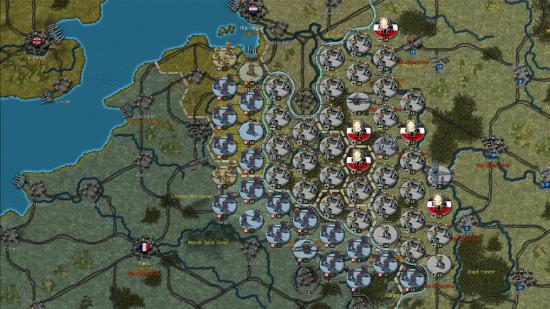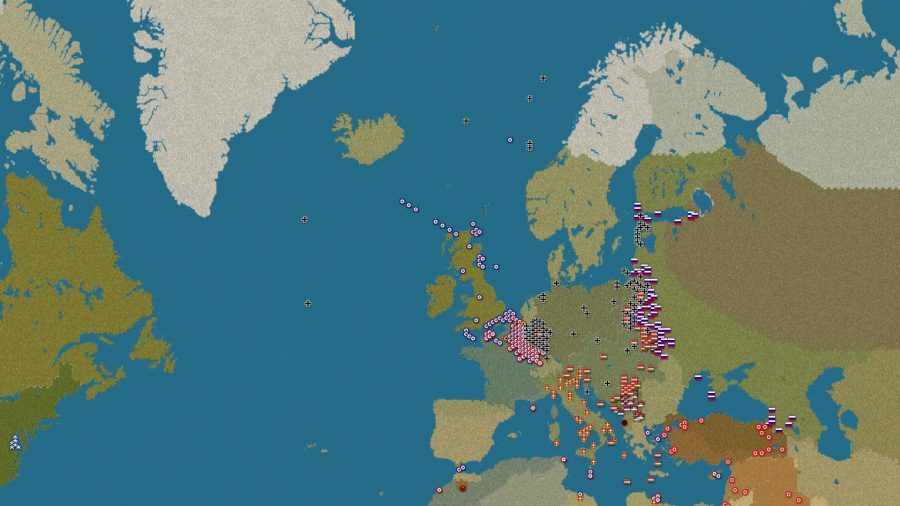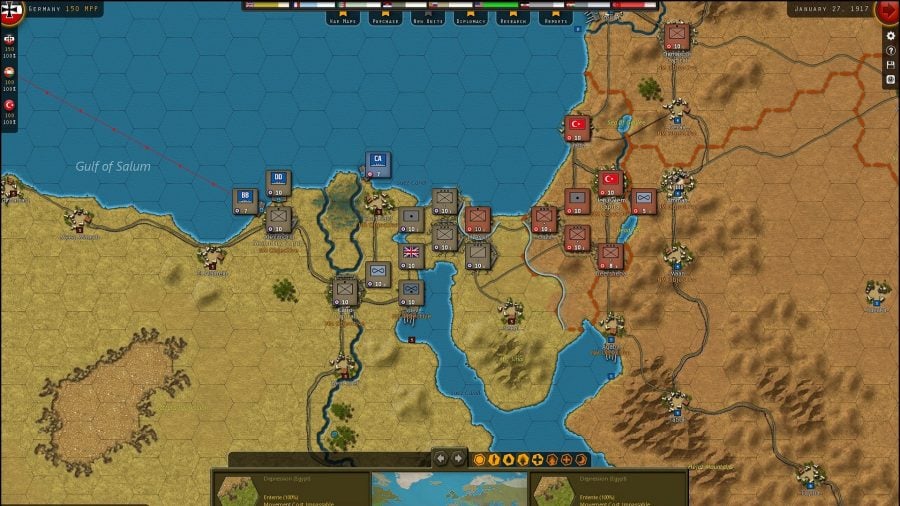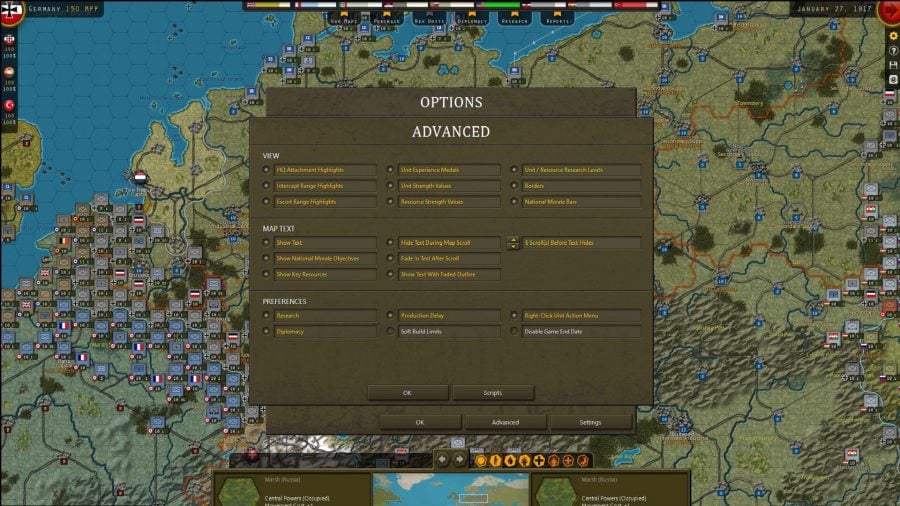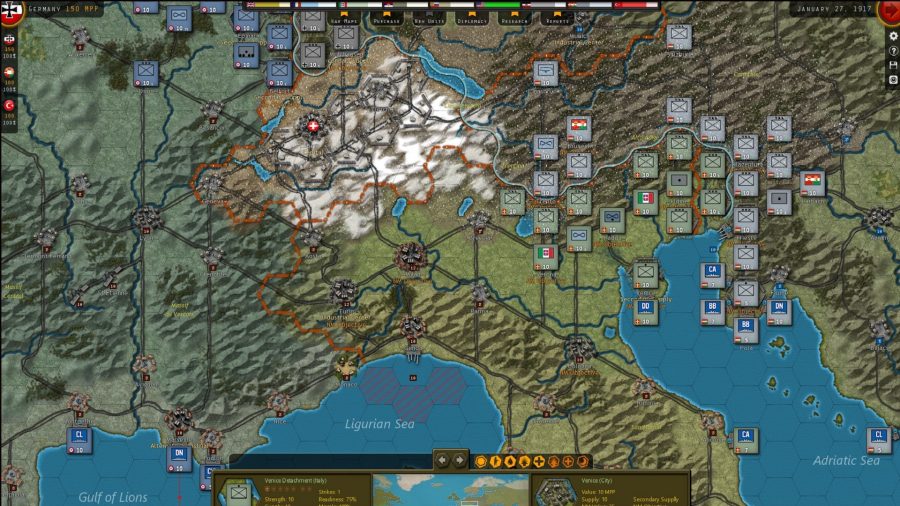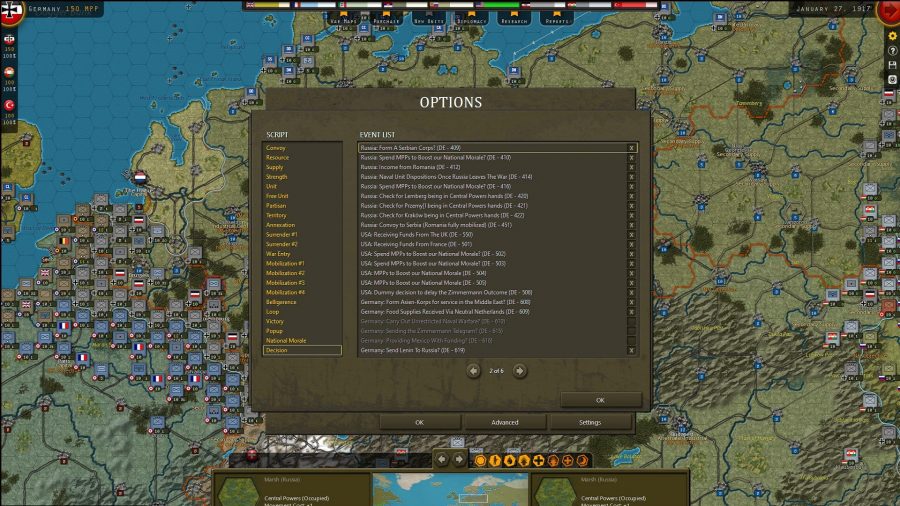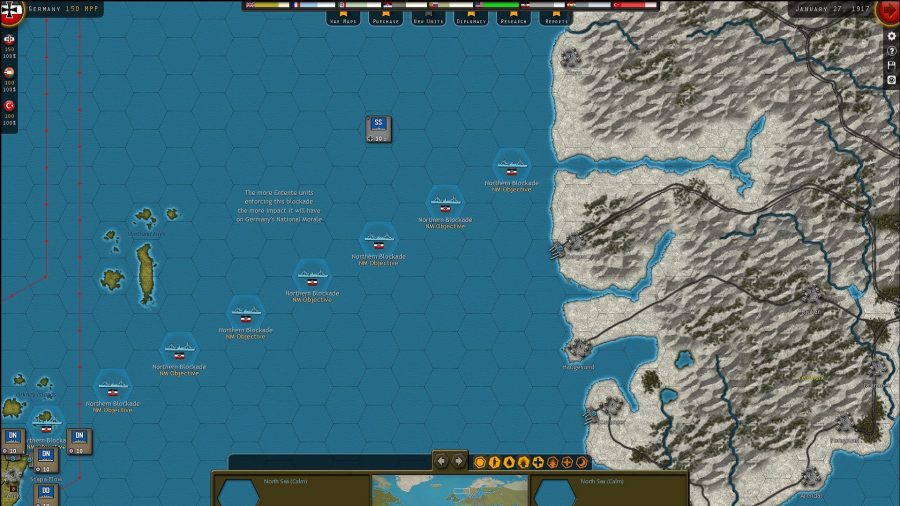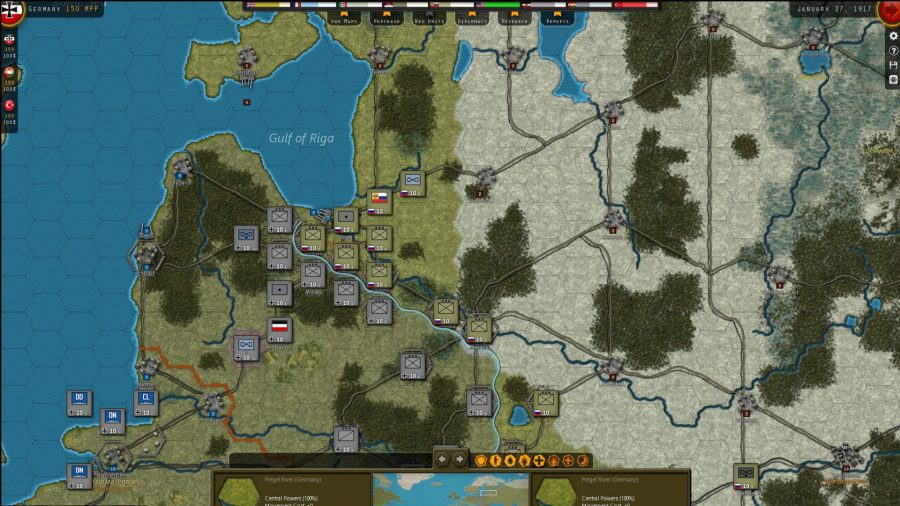This was a great Thanksgiving weekend for a couple of reasons. The first was not only that the wife and daughter took off for a weekend of Black Friday shopping, but, more importantly, that I wasn’t with them. The second was that this left me an entire three days to put into Slitherine/Fury Software’s Strategic Command: World War I, a sequel/do-over of their classic game of the same name. I had a blast.
The review copy I received was updated over the last several days, so it did add in the final campaign scenario, which starts the festivities in 1917, putting pressure on the Central Powers to win prior to US involvement. However, I didn’t get the player manual until very late so I had to use the one that came with Strategic Command WW2: World at War. Both use the same game engine and play is quite similar.
Don’t kid yourself though, SCWWI is different in many ways and this is a good thing. After playing the 1917 scenario, I have to say no game covering the Great War at this level comes as close to capturing the ambience of the period as this one. The game feels like World War I, lock, stock and two smoking Stosstruppen.
The game easily installed and is easy on hardware resources. I played it on my wife’s recently upgraded (by me) Dell workstation refurb boasting an Intel i5 3.4 GHZ processor, 32 Gigs RAM and an AMD Radeon R5-240 video card. This isn’t state of the art, yet all game functions ran smoothly, without error and very fast. I can always tell if my hardware is lacking by how easily I can move the screen around or zoom in and out with my mouse, and here there were no problems.
Because I don’t have the official manual, I’m not exactly sure what the respective scales are, but it seems player turns are about a month and units generally air groups, individual capital ships with escorts, submarines, other naval flotillas, with army corps and HQ for ground combat. SCWWI also simulates things like heavy artillery and Zeppelins.
You have a choice between NATO style counters or 3D icons, the latter looking a bit candy-land-ish. It must be the miniature player in me, but I simply cannot warp (no, not wrap, warp) my head around three generic soldiers towering above a city representing a 36,000-man corps. The only word I can think of is ‘juvenile’. Not to worry, because the Blue Max Mod is due release the same day as the game and it does have a non-NATO counter suite that is actually pretty darn good. Add to this a drop-dead gorgeous map, and the eye candy alone is worth the price.
The designers kept game controls to a minimum, and I really like the idea of right clicking on a unit to pop up a menu with options such as Reinforce or Entrench. Clicking a unit will also highlight all hexes it can reach by moving, or all units under a HQ’s control if the player selects that counter. A data box appears at the bottom when you make this selection, as does the description of the terrain the formation occupies.
More information should be in the game manual, which is several hundred pages. Do NOT let that scare you. First, a good 100 pages is reserved for making your own scenarios, while the rest are not so much involved with how to play the game, but rather the stats and processes behind what the player does or does not do. Sure, if you want to know exactly how Supply Points impact units by type over various distances, you can consult this weighty little tome and find out down to three decimal places (just kidding, maybe).
Or you could just play the game knowing that you only have a certain amount of supplies to distribute, and the farther away from your primary logistics source the tougher it is to make sure everyone has enough beans and bullets.
All this over one Archduke: The best WW1 strategy games
And naturally it gets worse if your Lines of Supply are in the mountains or far from a rail head. The game is quite intuitive and so while having oversight of such issues is important, knowing the gritty details the manual gives you is not. SCWWI uses what I like to call a ‘free form’ play format. This means you can do everything the game allows you to do in a turn, in any order you please, to include returning to continue earlier game functions.
The AI doesn’t do anything, and the entire game turn doesn’t end, until you hit the arrow allowing your digital foe to start its player turn and respond. Units function by expending Action Points, so you could move an infantry corps by spending APs, attack the enemy using more APs, turn your attention to enforcing a blockade, funding research, then go back to the corps in question and move it again if it has any APs left.
Here is where the game starts to feel very much like the Great War. Use an artillery unit to pound an adversary (and depending upon its supply state, these guns could fire up to ten times per turn, either at the same or different targets within range), attack with an infantry corps, expend excess APs to move the same corps backwards, then shift in a new corps to attack the same target again. It suggests a massive ground assault floundering against trenches, going to ground, withdrawing, and watching yet another wave of friendlies moves forward. The combat tables support this concept with a casualty matrix that is futility personified, so patience really becomes a virtue in SCWWI.
Units have strength points that are lost due to combat or attrition, but losses can be replaced up to their intrinsic supply levels, presumably by using Supply Points that support the army logistically, with each port or city (and HQs) possessing a number of SPs dependent upon its size. Convoy routes are another, though indirect, source of general supply. Capturing these areas or severing convoy lines will reduce the number of SPs available, thus making it more difficult for a country’s military to replace losses, support itself or conduct operations. Similarly, Zeppelin attacks against cities (instead of military units) will also permanently reduce that specific urban area’s SP total. In fact, after playing the game for a weekend, that seems to be the total raison d’etre for having airships.
These same SPs seem to also double as MPPs, or Military Production Points. These MPPs are the heart and soul of the grand strategic part of the game. Based on the territory and urban areas held, each major country receives a set number of MPPs per turn and the game allows turn to turn accumulation. The MPPs are really resource points and represent an aggregate total of a country’s ability to produce hardware and military units, conduct research, initiate diplomacy and more.
It’s a neat compromise and a very realistic one IMHO, very appropriate to the position held by the player as a leader of his country. You can, for example, begin research to produce tanks, but you do not have to fund and build specific types of mines, factories and railroads to support this effort. This is what kings and presidents have ministers for.
And you use MPPs for damn near everything at the strategic level. Want to influence a country to become an ally or delay joining the other side? Use MPPs. Want to manually research hardware such as new types of submarines.
So much for Versailles: Check out the best WW2 games
Use MPPs, and the AI will calculate your maximum expenditure and period for completion. It’s the same thing for automatic research which covers non hardware issues, such as new infantry tactics. These apply to your entire military force automatically at completion. But you gotta use MPPs.
Want to buy new infantry corps or rebuild those lost? Use MPPs. Want to transport an infantry corps operationally und uber schnell mit dem Eisenbahn? Use MPPs.
Then of course there are random events which pop up from time to time, things like “do we send aid to the Ottoman Empire?” But in a neat twist, the game allows you to turn off the scripts that cause these ill-timed situations to occur. So, let’s say you want to make sure the USA never enters the war. You can go into the dialog box and uncheck everything that says, ‘Unrestricted Submarine Warfare’ or ‘Zimmerman Telegram’, and all of a sudden you are a foreign policy genius!
You win the game by reducing your adversaries’ National Morale to zero. Said morale drops due to loss of territory, military losses and political events, but can increase if, for example, you’re the British player and you manage to sink a couple of dreadnaughts from the German High Seas Fleet. Italy, Russia and Austro-Hungary seem particularly vulnerable.
SCWWI comes with three campaign scenarios – the Guns of August 1914, Italy joining the Entente and 1917 prior to US intervention. I chose to play the latter as the Central Powers, making the strategic decision to target Italy as my Schwerpunkt to end the war. For software this comprehensive I found gameplay very quick and smooth, easy to complete within a weekend.
My plan had diplomatic, naval and ground components, and the maritime portion involved sending both the German and Austro-Hungarian High Seas Fleets on veritable death rides. The idea was to attract (trust me, it did) the French fleet and Royal Navy’s attention and trick them into abandoning their convoy lanes. This allowed me to take all the submarines at my disposal, form informal WWII style, multi-boat Wolf Packs and sit them at the junction of convoy lanes or where a convoy lane passed through a narrow straight.
I supported this effort by using my airship fleets to bomb towns and industrial centres, all with the objective of reducing the number of MPPs and derived reinforcements the Entente received each turn, the UK specifically. It worked and soon each turn there were 100+ new MPPs less than allocated before.
Tabletop trenches: These are the best WW1 board games
Also, I remember that in the Battle of Britain 23 years later it was manpower, not aircraft shortages, that drove London to the brink, so I figured degrading MPPs could indirectly ease Entente pressure on the Western Front.
Diplomatically, I flipped off the USA scripts, as noted above, and did not touch the convoy lane coming out of the United States. On the ground in the West, I pulled back the German army into Belgium to shorten my front line. This allowed me to send units south to support the Austro-Hungarians, and my doing likewise against Russia allowed the redeployment of even more units towards Italy.
In effect, this meant me holding both fronts with just enough German and allied forces to stall any offensive for what I hoped would be at least eight turns. I also husbanded my MPPs to build the maximum number of infantry and artillery formations, having them appear at the same time, mostly in Bavaria. Beforehand I also invested heavily in MPPs for Infantry Tactics and Gas Munitions, also keyed to the same time.
Then at the appointed date the entire weight of my legions fell on the Italians at Caporetto and the Venetian Plain behind. I then marched west down the contiguous valley and as the AI pulled other Italian forces from their positions in the Alps to counter me, nearby Austro-German forces advanced. The idea was to destroy the Italian army, knock that country out of the war, then swing my forces north thru Piedmont into southern France. Hopefully, the French would not react quickly, and a lightly defended Paris would fall.
Did it work? Well, it was tougher than I expected and took more time than I thought, but I will say its nice to see someone has developed an AI that doesn’t cheat and software that truly recognizes my military talents. HMS Furious’ raid on the Tondern Zeppelin base aside, I did find it odd to see a lot of fleet aircraft carriers in the game.
But like I said, quibbles. No matter what World War I PC games I’ve played before, it seems I always retreated back to Guns of August as a more proper cup of Earl Grey. Not anymore. With Strategic Command: World War I a usurper has seized the throne. The king is dead, long live the king!
